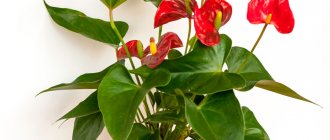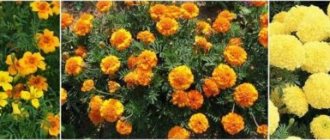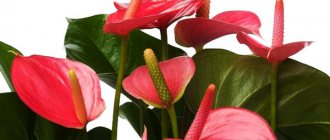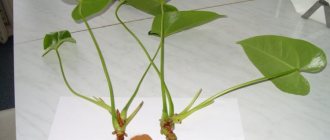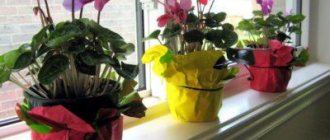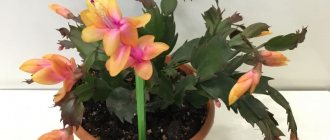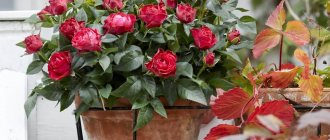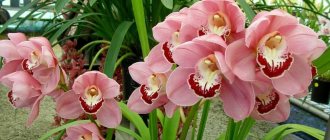How to make men happy? Flowering of homemade Anthuriums!
These natives of the Latin American tropics and subtropics with heart-shaped leaves on long petioles bloom spectacularly in indoor culture - and are believed to thereby provide the surrounding men with a healthy, happy and fulfilling life.
The genus name Anthurium is a composite of the Greek words for “flower” and “tail . Indeed, in about nine hundred species of this genus, the flower itself is shaped like a tail - white or dark, or colored, straight, curved or spirally twisted.
This inflorescence-cob is equipped with a more or less wide leaf-veil of a wide variety of colors and shades - red, white, green, orange, purple.
The odors emitted by flowering anthuriums are no less changeable: from subtle to very strong, from fragrant to fetid - it all depends on which pollinating insects are more often found where a particular type of anthurium grows.
In greenhouse and indoor culture Andre's anthurium and Scherzer's anthurium (including their numerous hybrid forms), beautifully blooming in white-pink-red tones, are most often grown crystal anthurium with discreet flowers that have a delicate pleasant aroma.
Anthurium juice is poisonous and care should be taken when working with them.
Flower design.
Karma red
Anthurium is irresistible both in single planting and in group planting. Groups of plants can consist of only anthuriums.
Sierra Magic
Combine different varieties, use many shades of red (from scarlet to burgundy). Make accents in the interior. Especially red anthurium inflorescences will emphasize the individuality of the owner and his interior. Combine the incompatible. An ideal combination of two types of anthurium with red and white inflorescences. Classic red will always be a bright spot in dense greenery or against the background of its own foliage.
Champion ed
When choosing varieties with glossy inflorescences or foliage, you will always pay attention to the beauty of these charming and sophisticated indoor favorites of many gardeners. Good luck to you.
How to make Anthurium bloom?
Indoor anthuriums are potentially capable of blooming from February to November , that is, almost all year round, stopping only in the coldest and darkest winter months; in addition, their flowers are unusually durable when cut and remain unchanged for up to four weeks.
For such fabulous flowering, these plants need appropriate conditions, the observance of which requires considerable experience and knowledge.
The main problem is to find a balance of light, temperature, soil and humidity that will remind anthuriums of their native high-mountain tropical forests and they will probably agree to live and reproduce in your apartment.
Creating an appropriate microclimate includes providing lighting - bright but diffuse ; quite long throughout the year.
Temperature
Summer temperatures should be maintained at 20-25 degrees , winter temperatures in the range of 16-18 degrees .
The soil temperature should not be lower than the air temperature, so anthuriums are planted in plastic containers . These containers should not be deep - but not too wide, otherwise they will grow roots and children, not flowers.
Air and soil
Air saturated with water vapor should be fresh - but without drafts.
The soil is moist - but not wet.
Fertilizing is needed - but fertilizer solutions should not be too concentrated.
Compliance with all these “ifs” and “buts” is the main condition for constantly blooming “male happiness.”
And now, finally, your anthurium has blossomed - but it’s too early to calm down. After some time, the bright red blankets turn green, or the rich pink variety turns white, losing its color. This is a normal phenomenon, this is how these plants fade - and the outdated flowers need to be removed .
It also happens that you purchased a luxurious variety with numerous large flowers - but at home it somehow thinned out, crushed and reluctantly forms new inflorescences.
This situation may arise due to the fact that when commercially growing anthuriums in greenhouses, gibberellins, phytohormones that accelerate the growth and overall development of all parts of the plant, are used to improve their presentation.
Where to put it.
For anthurium, it is advisable to choose a fairly bright place. Cover or shade from direct sun. This may cause burns on the leaves. It is better if the light is diffused throughout the room. Particular attention is drawn to drafts. Anthurium does not tolerate it.
Almera variety
— Lighting. Bright light, no direct sun. If there is insufficient lighting, additional lighting of the plants is provided. You can use phytolamps. Always try to place the plant closer to the window.
- Temperature. The temperature regime must be observed. Winter is not lower than 15 degrees. Summer – no higher than 25.
- Humidity. Anthurium has a positive attitude towards humidity. Spraying foliage or using air humidifiers has a good effect on care. But try not to get moisture on the inflorescences. This may cause dark spots. An alternative to spraying is preventative wet cleaning of leaves from dust and dirt.
How to care for the flower of Male Happiness to bloom?
Deprived of constant stimulation, the specimen gradually returns to its natural state and, if it is provided with proper care, will bloom again - albeit not so brightly and abundantly. Is it possible to replant Anthurium during flowering?
During this period, you need to
feed the plants: once every two weeks , with complex mineral fertilizer.
You can alternate organic and mineral fertilizers, but in any case, the concentration of the solutions should be weaker than the standard one. Anthuriums are species that are quite difficult to grow indoors . Sometimes this plant is given a separate “apartment” - a terrarium, in which, behind glass, they create a real tropical atmosphere for it, providing additional lighting, regulating the temperature, and saturating the air with water vapor. Anthuriums are also grown hydroponically.
However, these “tropicans” can easily grow without any special shelters or tricks.
True, there are interruptions in flowering: the red covers have turned green, you have removed the faded ones - but new flowers are not formed, although winter is still far away and otherwise, judging by its appearance, the plant feels good.
Sometimes a young specimen does not bloom or a transplanted anthurium grows but does not bloom.
All these problems have their own causes that can be eliminated.
If you wait and do not wait for the flowering of a specimen grown from seeds, remember:
If, as expected, in the interval between flowering, and not during it, you transplanted the anthurium into a new, expanded container - it may turn out to be too wide and flowering will not begin until the container is filled with roots and children. For flowering you need a small pot . You will find more information about planting and replanting anthurium here.
Why doesn't Anthurium bloom at home? Check that all conditions for proper care are met:
- The soil should be suitable for epiphytes - plants with aerial roots: loose, fibrous, moisture- and breathable, well-drained, ideally - special soil for orchids.
- Watering – ensures a constantly moist, but not stagnantly damp condition of the soil. The water is soft, its excess is immediately drained from the pan.
- Air humidity is significantly increased: you can add wet sphagnum on a tray to frequent spraying. Aerial roots are also covered with this moss.
- Fertilizing - twice a month, with a diluted solution of complex fertilizers.
- Temperature - during the flowering season not lower than 22 degrees (stimulates the development of buds), in winter - from 16 to 18 degrees (stimulates the formation of buds).
- The lighting is bright and at the same time diffused: a western or eastern window, supplementary lighting during short daylight hours.
If all these conditions are present, the anthurium is not too young, is not busy growing roots and forming children - and still does not bloom, you can try to stimulate it further .
To do this, in the spring, water the plant with soft water at a temperature of 40-50 degrees.
Some people pour water heated to 60 degrees into a pan once a week and leave it there until it cools, then drain it. The atmosphere of a warm steam room helps the anthurium to finally awaken to a full-blooded life.
Abundant, regular, exotic flowering of anthurium can be considered a successfully passed exam for the title of a diligent and skillful florist, and the happiness that should cover all domestic men, apparently, defies description.
Next you will see a photo of Anthurium blooming:
How to divide when transplanting?
The best time to transplant anthurium is spring .
It is recommended to replant adult plants once every three years, each time choosing a pot slightly larger than the previous one. Before replanting, the soil in which the anthurium grew must be saturated with moisture, then it will be easier to remove it without harming the root system. It is not recommended to choose a disproportionately large pot for replanting - if the root system takes up too little space in it, the anthurium will slow down its growth.
After completing the procedure, the plant will gain strength and actively develop over the next 3-4 months. During this period, just watering with water without adding fertilizers or fertilizing is enough - organic matter or minerals can penetrate into the wounds on the roots formed during transplantation and leave burns.
An adult, well-formed bush can also be divided and planted in different pots: “children” often form next to the main mother plant as it grows. The anthurium bush is divided simultaneously with its spring transplantation according to a similar algorithm.
How anthurium blooms, how many times, signs of flowering
Anthurium is popularly called the flamingo flower and men's happiness. The plant is given to men and young couples as a symbol of male strength and the ability to stand up for their family.
Features of anthurium flower
The name of the plant is made up of two ancient Greek words - flower and tail. But according to botanists, that part of the plant that looks like a flower is actually a colored leaf, a blanket. In nature it is green or white, but as a result of hybridization, varieties with brightly colored perianths have been developed: orange, pink, burgundy, purple.
Anthurium flowers consist of a perianth and a spadix
The anthurium flower itself is the so-called tail or spadix. It also comes in different colors (white, green, yellow, purple). In addition, the "tail" can be straight, spiral, or curved like a bird's neck.
Anthurium flowers with curved inflorescences are very similar to flamingo birds
The inflorescence itself is also complex; it consists of many small flowers in the shape of diamonds or squares. Moreover, anthurium has two flowering phases: female and male. In the female phase, the flower extends its pistil, and on its stigma you can see a drop of sweet liquid, attractive to pollinators. As soon as this droplet dries, the stamens with pollen move forward. Sometimes they are visible for several hours and then retract, revealing the pistil again. There are varieties in which both male (in the upper part) and female flowers (in the lower part of the inflorescence) are located on the cob. After pollination, berries with seeds are formed and distributed by birds.
Anthurium fruits that form after flowering
There are no blue or blue anthuriums in nature, but they are sold in stores and even have the spectacular name Alexia Blue. Breeders claim that anthurium does not have a blue pigment, so it is impossible to breed such a flower. Sellers simply add ink dye to the irrigation water. In this case, not only the flowers, but also the veins on the leaves can turn blue; the leaves themselves often have a dirty green color. You can buy such anthuriums; they will grow at home, but will lose their spectacular color. White anthuriums are most often painted; it is easiest to give them an unnatural color.
Blue anthurium at home will very soon turn white
Duration of anthurium flowering
Wild species bloom from several hours to several weeks. And on the windowsills of home gardeners, anthurium can bloom continuously. But there are varieties that bloom in the spring, and the flower lasts until mid-autumn. Other varieties, on the contrary, put out flower stalks in the fall and bloom until spring. Anthuriums have also been bred that do not bloom at all or are distinguished by modest, short-lived flowering, but have very beautiful leaves.
Anthurium with decorative leaves usually has inconspicuous flowers
How to understand that anthurium will bloom soon
Anthuriums ideally extend a peduncle from the axil of each leaf. This plant very actively forms root children, so flowers of different sizes may appear in one pot: large in the mother’s pot, smaller in the children’s. If you carefully monitor the anthurium, you will notice how arrows periodically appear from its base. The green arrow is a leaf, and the red arrow is a long-awaited bud.
The first to appear is the rolled up perianth (veil). Then the stem (peduncle) grows and raises the bud above the leaves. After this, the blanket unfolds, revealing the inflorescence.
Signs
The plant has long been endowed with many signs. It has been noticed that in a house in which anthurium grows, the level of positive energy increases significantly. The flower fills the house with harmony, enhances the intuition of its inhabitants, and encourages them to make important decisions.
In some countries, it is customary to give anthurium to young couples for a wedding , since such a gift, according to signs, gives the groom the masculine strength necessary for a happy start to family life.
You will learn more about the signs associated with anthurium from this video:
Caring for blooming anthurium
Blooming anthurium comes to us from the store, often as a gift. So that it does not die and pleases the donor and owner, you need to change the pot and soil. Indoor flowers are sold in soil that has no nutritional value. This is just a damp substrate in which the plant will not survive for long. You need to replant after about two weeks, without waiting for the end of flowering.
What should the pot be like for the anthurium to continue to bloom?
It is recommended to choose a plastic pot and not too deep. Clay allows moisture and air to pass through the pores, it is blown, and in winter the roots in such a container can freeze on the window. You cannot take a pot much larger than the one in which the anthurium grows. If you insert an old pot into a new one, there should be 1–2 cm between the walls, but no more. Having received space and nutrition, the flower will literally go to the root and will not bloom until it becomes cramped again.
Along with the pot, you can also buy a flowerpot. The pot is placed in a flowerpot, and the gaps between their walls are filled with moss, which must be constantly kept moist. Anthurium loves moist air, especially in winter, during the heating period.
Soil for flowering anthurium
The main condition for soil is looseness. If it is not followed, the plant will stop blooming and may get sick.
Under natural conditions, anthurium grows on leaf litter with the remains of rotten wood, so it won’t really like it in ordinary soil.
The store does not sell ready-made soil specifically for anthurium; it is suitable for azaleas, violets, orchids or for flowering indoor plants with an acidity pH of 5.5–6.5. Coarse fractions (at least 10%) must be added to the purchased soil: sphagnum, bark, small pine cones, charcoal. You can make up the soil mixture yourself: mix 2 parts humus, 1 part sand, 1 part peat, dry semi-ripe leaves, charcoal in pieces of different sizes and bark. The prepared soil must be sterilized (calcined in the oven).
Reproduction
Anthurium propagates by dividing the rhizome (shoots), cuttings and seeds.
Rhizome division
An overgrown flower can be divided during transplantation or the shoot can be separated from the mother plant. If the shoot does not have roots, you need to place it in moist sphagnum. If there are roots, the young plant is immediately planted in the soil. For the first 2 days it should not be watered, you just need to humidify the air around the flower.
Cuttings
If an adult anthurium has become very elongated, you can cut off the top of the stem with 2-4 leaves. At the same time, the remaining “stump” will quickly give rise to new side shoots.
The cuttings are rooted in sphagnum or a mixture of sphagnum, bark and charcoal. The container is covered with polyethylene and placed in a well-lit place. The substrate is moistened as necessary. The optimal temperature for rooting is 24-26 degrees. When the cutting takes root and begins to grow, it can be transplanted into an individual pot.
Growing anthurium from seeds
It is necessary to use fresh seeds as they quickly lose their viability. They are sown on the surface of a substrate consisting of sand, peat and leaf soil. The container is covered with glass and ventilated regularly. After 7-10 days, shoots appear, after 1-1.5 months - the first true leaf. After 2-3 months, the seedlings can be transplanted.
Secrets
Since anthurium is an epiphytic plant, like an orchid, and has aerial roots, it cannot be planted directly in universal soil, as this causes rotting of the root system and death of the entire flower.
The soil plays the most important role in the process of organizing conditions for year-round flowering of anthurium.
To ensure long life and abundant flowering, it is important to choose the right substrate in which the roots will feel comfortable.
It is recommended to purchase soil for orchids at a specialized store, but you can make it yourself by mixing high-quality charcoal, which serves as a base, as well as fallen leaves and pine bark, which are rich in nutrients.
Most of the mixture should be bark, which should be chopped into medium-sized pieces. You need to add light coniferous and leaf soil to it and mix thoroughly. The soil should be lush, easily permeable to moisture, which the plant also needs. Therefore, you need to add good wood ash to the mixture - not too fine, but not turned into powder. This part should not exceed 10% of the total volume of the substrate.
It is important to monitor the acidity of the soil - it should be slightly above average. In such conditions, epiphytes feel most comfortable.
Pots for these flowers should be small, since in large containers the root system develops too slowly, which negatively affects the set of green mass and the budding process.
It is necessary to provide good drainage in the pot to avoid stagnation of water. After planting the flower, it is recommended to cover the soil with large pieces of pine bark, which will maintain the required level of humidity and saturate the substrate with nutrients.
Watering is no less important for the constant flowering of this epiphyte than the composition of the soil. It is advisable to carry out the procedure regularly, without allowing the earthen clod to dry out too much. However, the amount of water should be moderate, since its excess can cause rotting of the root system. It is better to water the plant with settled water at room temperature. You can sometimes add a few drops of lemon juice to it.
What are the difficulties when growing and maintaining anthurium?
Diseases of the root system can lead to withering and death of the plant. This can also happen if there is hardened soil in the pot. In these cases, transplantation helps, which is preferably done once a year. To do this, with extreme care, the anthurium is removed from the container and planted in a new one, with soil and the addition of bark, moss and charcoal. After that, the dried leaves are removed and the trunk is sprayed with water. During the period after transplantation, it is worth feeding the plant with fertilizers based on mineral elements, as well as vitamins.
The wilting process can be caused by a lack of sufficient heat. In addition, the plant begins to wither in the presence of a disease such as fusarium. The process can also be caused by excess moisture in the soil, infections that occur through contact with pets or the gardener’s dirty hands.
Flower growers cannot help but make mistakes when growing such a whimsical plant as anthurium. But in order to avoid them and minimize them, it is worth knowing the basic rules for caring for it. Poor growth and development of the bush can be caused by a lack of lighting and watering. If this happens, then you need to feed the flower for better growth.
Fortunately, the flower is extremely rarely susceptible to disease. Diseases and pests in anthurium can occur due to improper care. Yellow leaves appear due to lack of sunlight. When the foliage darkens and begins to rot, this indicates that the room is not warm enough. The main pests of anthurium are aphids and scale insects. Failure to wipe the leaves can lead to spider mites.
Anthurium: what to do to make it bloom
On the South American continent, it is believed that the aroid perennial grows even when simply thrown onto the ground, without any care - anthurium blooms there in any case. This is the only way a tropical resident behaves in natural conditions, that is, in subtropical and tropical climates. There are favorable conditions for the development of anthurium and the production of bright inflorescences. But in cases where “women’s happiness” grows on a windowsill in a room in an average climate, anthurium at home may not bloom at all.
What to do next when the plant has flowered?
After the anthurium has faded, the old flowers must be carefully separated from the main plant by cutting off the fading buds. The formation of seeds contributes to the weakening of the plant, and it is important not to miss the beginning of this process.
In general, keeping and breeding anthuriums does not cause much trouble ; they are much less capricious than their distant relatives - orchids. Creating favorable conditions for their growth is not difficult at all, even in a typical city apartment. Anthurium is a very responsive and grateful plant: proper care will be rewarded with long, colorful flowering.
Reasons why anthurium does not bloom
This perennial is called not only “women’s happiness,” but also “the flower of love.” Its beautiful flowers are distinguished by shades of red, white, burgundy or pink, as well as the striking oblong shape of the foliage. Although it often happens that the “flower of love”, which has bloomed many times already, does not bloom for a long time. There are many reasons for this phenomenon.
“Women's happiness” loves comfort, regular watering and good care. If the plant is placed in a room where the temperature and humidity conditions are not suitable for it, it will not only not bloom, but may even perish. This plant is a capricious plant. Anthurium blooms even in comfort worse than in its homeland. The article describes some reasons why a plant “does not want” to bloom and ways to “force” it to produce flower stalks.
Incorrect lighting
Anthurium is a light-loving indoor flower, but still prefers diffused sunlight, which should illuminate the plant for as long as possible. Therefore, the flower must be placed on a windowsill, which is located under a window facing east or west, placing it closer to the glass. Inexperienced anthurium lovers often place the flower in bright sun, believing that this way it will bloom faster. After all, he comes from the sunny tropics. Others, seeing that a plant on a sunny windowsill does not put out flower stalks, move it to a dimly lit room. But the plant does not bloom in such conditions at all. Bright sun can cause burns of leaves and flowers, and a semi-dark existence will not lead to the development of flower shoots. Anthurium blooms under certain lighting conditions.
Incorrect watering mode
It is better to water “female happiness” moderately, with soft water, which is left in the room for about 5 days. On hot summer days, it is necessary to spray it twice a day and wipe the leaves every seven days, removing dust from the leaves. In winter, the water should be a little cooler than in warm weather; you can also water the perennial with filtered water. How much water should I pour into the pot? The soil should not be waterlogged. If the top layer in the pot is kept too wet or constantly dried out, then this “flower of love” will not bloom even in excellent lighting and comfortable conditions.
Water the perennial so that water does not fall on the glossy surface of the green leaves. If drops remain there, the leaves will begin to darken. The soil in the pot should always be moist. The air should also have high humidity. Where the anthurium “came” from, there are constant showers. For this reason, the watering regime is the most important for the plant. Then the anthurium blooms profusely.
- for irrigation, use only settled water without any additives or impurities;
- watering the soil should be plentiful, but stagnation of water is unacceptable either in the pot or in the pan;
- the temperature of the water for irrigation should be at room temperature;
- every day, morning and evening, the anthurium is sprayed with a spray bottle;
- when the plant is placed on a windowsill above a heating radiator, vessels with water should be placed nearby to increase the humidity level;
- Excess water in the ground causes rotting of the root system, and if there is insufficient moisture, the leaves dry out.
Unfortunately, it is impossible to create complete comfort for a perennial. Where the “flower of love” grows, the air humidity is almost 100%, thanks to the constant fog. This is impossible in indoor or greenhouse conditions.
Temperature
The capricious anthurium feels comfortable in winter in indoor conditions. During normal operation of the radiator heating, the temperature regime of +20° C is most suitable for perennials. And if it’s hot, the flowers won’t set. It is best if there is an air conditioner operating near the ceiling in the room to regulate the temperature.
Wrong soil
It happens that the soil is chosen incorrectly, this is the reason the plant refuses to produce flower arrows. Peat, for example, is not suitable for perennials; its roots prefer humus and good drainage. It is also a mistake to plant the plant in soil that is intended for succulents or palm trees. The most suitable soil for “female happiness” is soil for orchids, which consists of humus mixed with charcoal, particles of bark and moss (sphagnum). When peat is added to the soil mixture, the plant will refuse to bloom.
Incorrect feeding
Regular fertilizing with acid-type fertilizers can help the tropical guest bloom. Such fertilizing is done no more than once a month, using liquid fertilizers. You can also add pine needles to increase acidity. Calcium should not be present in such fertilizers; its excess causes rotting of the roots.
Errors during transplantation
Anthuriums also need to be replanted correctly. Otherwise it will never bloom. This requires the correct selection of soil and pot size. Damage to the roots during transplantation can even lead to the death of the flower. The small container is periodically replaced with a larger one. This is done to prevent roots from growing through the holes in the bottom. A pot that is too wide or high is also unacceptable. It should be 2-3 centimeters wider than the previous one, and approximately the same in height. There should be enough soil in the pot so that the roots are completely hidden by it.
Other reasons
Inexperienced gardeners are surprised when a gift of a flowering indoor anthurium stops flowering after some time, although all care errors have been corrected. There are several other reasons for this:
- stems or roots are affected by disease or pests;
- frequent rearrangement of perennials from one lighting level to another;
- the flower pot is located in a draft;
- low air temperature also does not contribute to the development of flower buds on the stems;
- a lack of fertilizer or its excess often leads not only to the fact that the plant does not bloom, but also to its death;
- The flower stalks are left on the stem after flowering and must be removed to the base.
Hibiscus
The evergreen hibiscus bush (Hibiscus) belongs to the mallow family. The flower with red flowers is better known as Chinese rose. Hibiscus is native to China and India. From here, the plant spread throughout Europe along the Silk Road.
The tree-like plant reaches a height of 3 m. It is a long-lived plant, capable of living for about 30 years.
Hibiscus has dark green leaves with a jagged edge up to 15 cm long. Funnel-shaped flowers with a diameter of up to 16 cm. Flowering begins with the arrival of spring and lasts until October. The flower is unpretentious in care.
Hibiscus loves bright light and warmth. Summer temperature 20-25°, winter 15-20°. In spring, abundant watering is required, and in winter, moderate watering. On hot days, the leaves are sprayed.
Having studied many reviews, unofficial and professional ratings, we have compiled our own list of the most popular indoor flowers . We present you their photos and names with a brief description of each of them.
Why did anthurium stop blooming?
It happens that anthurium blooms magnificently, and then stops flowering and new foliage does not appear.
First of all, the plant needs to be replanted. A flower bought in a store especially needs this. Indoor flowers arrive on store shelves in shipping containers with a small amount of peat, fertilizers and chemicals. The supply of these funds is designed for a month - two flowerings. But at this time there is no development of roots and foliage. If the plant is not replanted in time, it will become exhausted and die.
After this, the anthurium needs some period to strengthen the roots and ground parts. Often this period extends for several months. Sometimes pets that were pleasing to the eye with lush inflorescences stop blooming. In these cases, the method used in industrial greenhouses or conservatories is often used. For this purpose, from late autumn the plant is placed in a well-lit room where the temperature is maintained from 16° C to 20° C. If necessary, artificial lighting can be added.
“Women's happiness” is watered regularly, but not as abundantly as in the summer. Then, after a couple of months, when new stems and leaves appear on the ground part of the bush, it needs to be moved to a warmer room and watering increased. The most comfortable temperature will be around 23° C.
If the plant has not yet bloomed, it will definitely send out peduncles. Anthurium blooms in the spring and this period lasts a long time: about one and a half to two months, if you remember to follow the rules of flower care.
Types of anthurium with photos and names
Anthurium andraeanum
This epiphytic plant is found naturally in the mountain forests of Ecuador and Colombia. There are aerial roots, but the stem is not long. The large, glossy, rich green leaf blades have a petiole and a heart-shaped shape. The leaves are about 20 centimeters wide and up to 40 centimeters long. During flowering, a large cylindrical ear of cream, white or light yellow color is formed. Its length can reach up to 10–15 centimeters. The large glossy leathery blanket is heart-shaped, its color is rich and can be salmon, red, white, pink, etc. Flowering duration is about 6 weeks. When the bush fades, the spathe will have a pale green tint. This species has a large number of varieties and hybrids.
Baker's Anthurium (Anthurium bakeri)
This epiphyte has a short stem and belt-like narrow long leaf plates (width - about 10 centimeters, and length - up to 50 centimeters). The front surface of the leaves is green, and on the back there are brownish-red dots. The height of the peduncle is from 10 to 30 centimeters. At the top, a pale cream-colored cob is formed, the length of which is from 5 to 10 centimeters. The edge of the pale yellowish-green blanket is lilac, it itself is leathery, reaches up to 25 mm in width, and up to 50 mm in length. The small berries are deep red in color.
Anthurium magnificum
There are both epiphytes and terrestrial varieties. The appearance is similar to crystal anthurium, but unlike it, the petiole in cross-section is not round, but tetrahedral. The veining on the foliage is olive rather than silver, and there is also a longer spathe.
Anthurium hookeri
In nature, such an epiphyte is found in tropical forests. The wide, large leaf blades are painted a rich green color, and there are many black dots on both the back and front surfaces. The leaves have petioles, the length of which is about 15 centimeters (some are shorter), as a rule, in cross section they have the shape of a triangle. The length of the peduncle varies from 50 to 100 centimeters. The length of the pale purple or light pink cob is about 30 centimeters. The green blanket is about 5 centimeters wide and up to 20 centimeters long. White fruits have a red upper part.
Anthurium scandens
The species is represented by a climbing epiphyte, which is shade-tolerant. The powerful roots are quite thick, the stem can reach about 100 centimeters in height. The foliage can have different shapes (depending on the variety), it can be oval or lanceolate. The leathery leaf blades have many small black spots on the underside. The length of the peduncle is from 50 to 60 mm, it is colored in a pale red or green shade. The thickness of the yellowish-green cob is up to 0.2 cm, and its length is about 2 centimeters. The length of the greenish blanket is about 10–15 centimeters, while its width is up to 0.5 centimeters. Depending on the subspecies or variety, the fruits of such anthurium can be colored pale purple, white or dark purple.
Anthurium polyschistum
This vine is decorated with palmately dissected foliage. The shape of each part of the leaf plate is lanceolate, and their edge is wavy, width is 1.5 centimeters, and length is 15 centimeters. The height of the peduncle can reach about 25 centimeters. The length of the cob and the spathe is the same, and is about 10 centimeters. The color of the berries is red.
Anthurium crystallinum
The caudex of this epiphyte is short and can be located underground. The leaf plates, velvety to the touch, have a petiole, they are painted in a dark green shade, the width is about 20 centimeters, and the length is up to 40 centimeters. On the front surface of the leaf there is a glossy silver vein. The height of the peduncle is about 50 centimeters. A cob about 25 centimeters long is formed on it, as well as a green-purple blanket, the width of which is about 2 centimeters and the length is up to 10 centimeters. The fruits are purple in color.
Anthurium scherzerianum
This epiphyte is decorated with matte dark green foliage that is leathery to the touch. Its shape can be elliptical or lanceolate (depending on the variety), the length of the petioles is 5–20 centimeters. There are many black dots on the front and back surfaces of the plate. The height of the peduncle is 15–50 centimeters. The yellow or orange spiral cob is about 80 mm long. The rich orange-red blanket has an oval or ovoid shape, its length is about 12 centimeters and its width is up to 6 centimeters. The fruits are orange-red.
Types and varieties of indoor Anthurium. Description and photo.
Diseases
Failure of a plant to produce flower stalks often results in disease.
- Sometimes dark spots appear on the surface of the leaves. The reason for their appearance is that the temperature in the room is too low. Essentially the plant freezes.
- Infections often affect all parts of the “flower of love.” Anthurium can be infected by viruses and microorganisms. There is no countermeasure against them yet, and therefore such diseases lead to the death of the bush.
- Some infections can be treated with chemicals sold in stores. For example, in some cases you can get rid of the infection with potassium permanganate or Glyokladin.
- Fungal diseases are treated with fungicides. But this is only possible with timely treatment.
Pests
The most common insects that like to settle on anthurium are:
- aphid;
- thrips with scale insects;
- spider mites;
- root nematode.
These insects, being parasites, suck juice from any parts of the flower, depriving them of nutrition. Signs of the appearance of insect pests can be determined during hygiene procedures regularly carried out during care.
Why anthurium does not bloom at home: how to find an approach to an exotic plant
White anthurium and other species: cultivation, reproduction, diseases
Anthuriums - conditions of detention, care, reproduction
How to grow and propagate anthurium at home
When does anthurium bloom at home?
The flower “male happiness” or the flamingo plant – people give anthurium different names, but this does not change the characteristics of the plant. The timing of flowering is strictly determined by the development cycle of anthurium. How often and for how long should your anthurium bloom at home?
When does anthurium bloom at home : from early spring to autumn, but most only in winter. Anthurium Andre, for example, is a plant with constant flowering.
How long does anthurium bloom : up to 3-4 weeks with the most comfortable care. We will look at where to place anthurium to bloom longer in the second part of this article.
Bloom
The maximum decorative effect of anthurium is observed during flowering. Let us not reveal the secret that most flower growers grow it just for the sake of beautiful flowers.
In order for “male happiness” to bloom, in addition to proper care, it must be kept for 45-60 days in winter at a temperature of 16-18 °C and provided with a sufficient amount of diffused light.
How many times a year does it bloom and for how long?
As a rule, in favorable conditions, Andre's and Scherzer's anthuriums bloom once a year from March to October. They can continue in winter if they are well lit, but not so abundantly.
Some hybrid varieties, with proper care, can bloom throughout the year. The plant often blooms in summer and autumn, much depends on its condition and growing conditions.
How long does it take to bloom at home?
Bedspreads can last up to three months, on average 15-30 days, depending on many factors.
Care after flowering
First, the inflorescence is pruned to increase the flowering period and stimulate the appearance of new flowers by saving vitality.
Then switch the anthurium to winter mode (lower air temperature, infrequent watering). The dormant period will lay the foundation for future flowering, but remember that lighting cannot be reduced, but rather additionally illuminated.
How to prune faded flowers?
After the cover has dried, you can trim it, but leave the peduncle untouched. After a while it will dry out on its own and will be easy to separate from the stem. If desired, you can cut off half of the peduncle, and the remaining part will wither and then simply separate.
Withered flowers do not interfere with the formation of new ones, and they can be cut off only after the cover has dried.
Advice
If you want to give flowers to someone or just put them in a vase at home, then cut only well-formed inflorescences, and they will last for 3-5 weeks. Flowers that are not fully formed fade after a few days.
When the flower fades, the blanket loses its bright color, for example, red becomes green, and pink becomes almost white.
"Picasso Orange", "Baby Orange" and "Madural Orange"
Why doesn't anthurium bloom at home?
Different types of anthurium allow you to choose a variety with flowering to suit your schedule, but the plant is extremely capricious and can go on strike, not wanting to form buds. This turn of events can only be prevented by proper care. What kind of care is wrong?
Why does anthurium not bloom at home:
- The soil is not sufficiently moistened;
- Frequent flower rearrangements;
- Anthurium is in a draft;
- Little sunlight;
Anthurium flowering continues for several weeks if the apartment is moderately warm and has access to sun and moisture. By placing male happiness on the windowsill in the spring, you can achieve longer flowering. In winter, make sure that the anthurium does not stand in the shade or in a draft, and also check the soil in the pot - it should be constantly moist and dry out a little a day before the next moistening. Try to move the anthurium as little as possible - it is one of those plants that do not like rearrangements (ficus too).
Anthuriums of hybrid varieties were bred for modest but unusual flowering, so your representative of the Madagascar plant may be among them and delight with inflorescences for a very short time. Remember what variety you were told when purchasing and write in the comments to learn more about its cultivation rules and flowering period.
Temperature and humidity
The flower is a heat-loving plant. A good temperature is considered to be 20 C. As for winter time, the optimal temperature for anthurium is 18 C. At 15 degrees he begins to feel unwell. The sprayer should be used regularly about 2 times a day. Anthurium does well in cool rooms such as the bathtub. In the summer, the flower is usually placed outside and placed in a place where there is no direct sunlight. During the flowering period, Anthurium needs fertilizer. It is recommended to carry out this procedure about 2 times a month in winter, and once every 11 days in summer.
